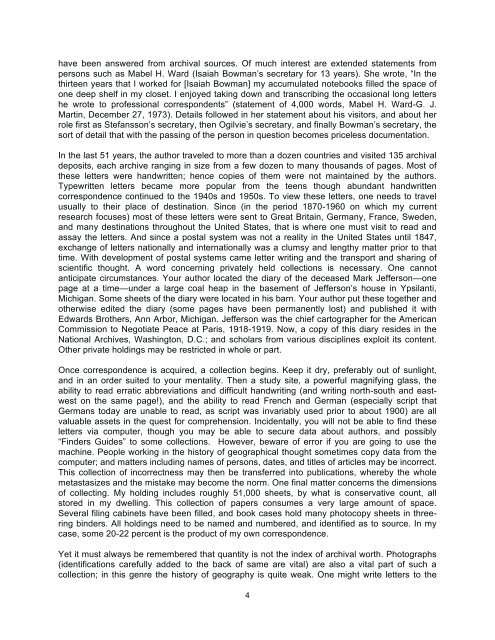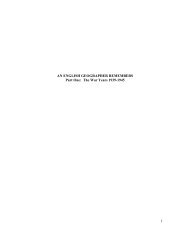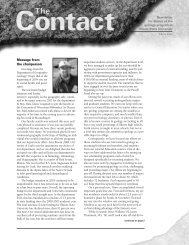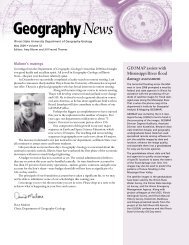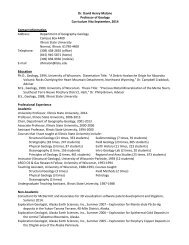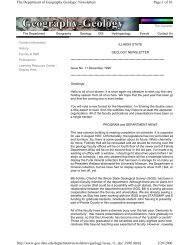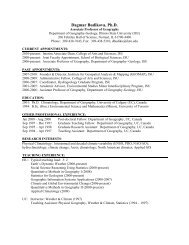Glacial Deposits.indd - Department of Geography - Geology - Illinois ...
Glacial Deposits.indd - Department of Geography - Geology - Illinois ...
Glacial Deposits.indd - Department of Geography - Geology - Illinois ...
You also want an ePaper? Increase the reach of your titles
YUMPU automatically turns print PDFs into web optimized ePapers that Google loves.
have been answered from archival sources. Of much interest are extended statements from<br />
persons such as Mabel H. Ward (Isaiah Bowman’s secretary for 13 years). She wrote, “In the<br />
thirteen years that I worked for [Isaiah Bowman] my accumulated notebooks filled the space <strong>of</strong><br />
one deep shelf in my closet. I enjoyed taking down and transcribing the occasional long letters<br />
he wrote to pr<strong>of</strong>essional correspondents” (statement <strong>of</strong> 4,000 words, Mabel H. Ward-G. J.<br />
Martin, December 27, 1973). Details followed in her statement about his visitors, and about her<br />
role first as Stefansson’s secretary, then Ogilvie’s secretary, and finally Bowman’s secretary, the<br />
sort <strong>of</strong> detail that with the passing <strong>of</strong> the person in question becomes priceless documentation.<br />
In the last 51 years, the author traveled to more than a dozen countries and visited 135 archival<br />
deposits, each archive ranging in size from a few dozen to many thousands <strong>of</strong> pages. Most <strong>of</strong><br />
these letters were handwritten; hence copies <strong>of</strong> them were not maintained by the authors.<br />
Typewritten letters became more popular from the teens though abundant handwritten<br />
correspondence continued to the 1940s and 1950s. To view these letters, one needs to travel<br />
usually to their place <strong>of</strong> destination. Since (in the period 1870-1960 on which my current<br />
research focuses) most <strong>of</strong> these letters were sent to Great Britain, Germany, France, Sweden,<br />
and many destinations throughout the United States, that is where one must visit to read and<br />
assay the letters. And since a postal system was not a reality in the United States until 1847,<br />
exchange <strong>of</strong> letters nationally and internationally was a clumsy and lengthy matter prior to that<br />
time. With development <strong>of</strong> postal systems came letter writing and the transport and sharing <strong>of</strong><br />
scientific thought. A word concerning privately held collections is necessary. One cannot<br />
anticipate circumstances. Your author located the diary <strong>of</strong> the deceased Mark Jefferson—one<br />
page at a time—under a large coal heap in the basement <strong>of</strong> Jefferson’s house in Ypsilanti,<br />
Michigan. Some sheets <strong>of</strong> the diary were located in his barn. Your author put these together and<br />
otherwise edited the diary (some pages have been permanently lost) and published it with<br />
Edwards Brothers, Ann Arbor, Michigan. Jefferson was the chief cartographer for the American<br />
Commission to Negotiate Peace at Paris, 1918-1919. Now, a copy <strong>of</strong> this diary resides in the<br />
National Archives, Washington, D.C.; and scholars from various disciplines exploit its content.<br />
Other private holdings may be restricted in whole or part.<br />
Once correspondence is acquired, a collection begins. Keep it dry, preferably out <strong>of</strong> sunlight,<br />
and in an order suited to your mentality. Then a study site, a powerful magnifying glass, the<br />
ability to read erratic abbreviations and difficult handwriting (and writing north-south and eastwest<br />
on the same page!), and the ability to read French and German (especially script that<br />
Germans today are unable to read, as script was invariably used prior to about 1900) are all<br />
valuable assets in the quest for comprehension. Incidentally, you will not be able to find these<br />
letters via computer, though you may be able to secure data about authors, and possibly<br />
“Finders Guides” to some collections. However, beware <strong>of</strong> error if you are going to use the<br />
machine. People working in the history <strong>of</strong> geographical thought sometimes copy data from the<br />
computer; and matters including names <strong>of</strong> persons, dates, and titles <strong>of</strong> articles may be incorrect.<br />
This collection <strong>of</strong> incorrectness may then be transferred into publications, whereby the whole<br />
metastasizes and the mistake may become the norm. One final matter concerns the dimensions<br />
<strong>of</strong> collecting. My holding includes roughly 51,000 sheets, by what is conservative count, all<br />
stored in my dwelling. This collection <strong>of</strong> papers consumes a very large amount <strong>of</strong> space.<br />
Several filing cabinets have been filled, and book cases hold many photocopy sheets in threering<br />
binders. All holdings need to be named and numbered, and identified as to source. In my<br />
case, some 20-22 percent is the product <strong>of</strong> my own correspondence.<br />
Yet it must always be remembered that quantity is not the index <strong>of</strong> archival worth. Photographs<br />
(identifications carefully added to the back <strong>of</strong> same are vital) are also a vital part <strong>of</strong> such a<br />
collection; in this genre the history <strong>of</strong> geography is quite weak. One might write letters to the<br />
4


